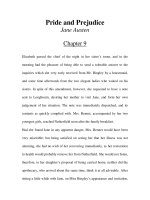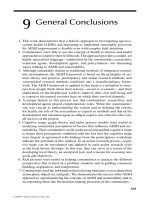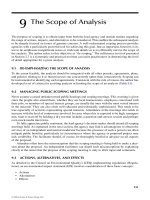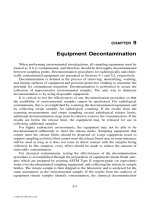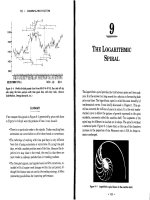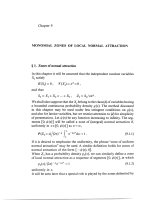Water harvesting and soil moisture retention - chapter 9 pps
Bạn đang xem bản rút gọn của tài liệu. Xem và tải ngay bản đầy đủ của tài liệu tại đây (274.81 KB, 19 trang )
Reducing evaporation losses and optimizing the use of soil moisture
77
9 Reducing evaporation losses and
optimizing the use of soil
moisture
9.1 Windbreaks
Windbreaks can be non-living structures such as brushwood and
woven palm-frond fences or living hedges such as lines of shrubs,
trees or tall grasses. In areas prone to wind they give shelter to crops
and reduce evaporation of soil moisture because wind low to the
ground is prevented. On slopes or fields affected by strong wind, live
hedges or windbreaks are effective.
In addition they reduce the speed of run-off and they (living fences)
provide organic material to the soil through their leaves. Their roots
open up the soil which improves infiltration.
Siting
Windbreaks and live hedges have to be sited at right angles to the
most damaging winds (Figure 35). When windbreaks are planted
across a hill side, they should follow the contour lines.
Figure 35: Siting of windbreaks.
Water harvesting and soil moisture retention
78
Planting procedure
Two examples will be given: Acacia spp. and Napier grass.
? Acacia spp. may be established from seeds or seedlings. Seeds are
sown in strips or hills. These are spaced at a distance of 0.5 to 1 m
within a row, the rows being 1 m apart.
? Napier grass is planted by cuttings, in hills which are spaced
20-30 cm apart. The rows are 30-50 cm from each other.
When you want to set up a tree windbreak, grass strips can be
planted on the windward side of the trees in order to protect the
tree-seedlings against the wind. Grasses may be retained as ground
cover, once the trees are fully grown. Trees with little undergrowth
can also be reinforced with loose branches near the ground. Wind-
breaks should not be too windproof, otherwise damaging whirl-
winds may form on the lee side.
Suitable species for windbreaks
Deep rooting species are suitable for windbreaks, because they do not
compete for moisture with nearby crops. The use of trees with high
evapotranspiration (like eucalyptus) should be avoided. Different
types of Acacia and Prosopis give a good windbreak after four or five
years. Napier grass is a grass commonly used as windbreak.
Figure 36: A ditch between hedge and crop to avoid root interfer-
ence.
Reducing evaporation losses and optimizing the use of soil moisture
79
Maintenance
Live hedges have to be regularly pruned to force them to thicken at the
base. Prunings can be used as mulch or animal feed. Roots of shrubs
and trees can also be trained to grow deeper by regular trimming.
Competition in the root zone between hedge and crop can be reduced
by digging a ditch between them to force the shrub to grow deeper
(Figure 36).
Constraints
? Live windbreaks have to be protected for approximately three years
against animals and humans.
? Some species (e.g. Euphorbia balsimifera) may provide a shelter to
rodents and snakes.
? There is a risk that plant diseases and pests will survive in the living
plants of the windbreak during the period in which the crop is not
on the fields.
9.2 Dry and sparse seeding
Dry seeding, i.e. sowing in advance of seasonal and unreliable rains, is
a widespread means of making the best use of available moisture. It
may even be necessary on soils that become difficult to work when
wet. There is a risk of premature germination before enough rain falls.
Figure 37: Plant density adapted to moisture availability.
Water harvesting and soil moisture retention
80
Sparse seeding means that planting or sowing density is adapted to the
availability of water at a certain site. It optimizes soil moisture use by
giving each plant room to spread its roots and collect moisture. In Mo-
rocco farmers traditionally use this principle when planting. In Figure
37 the crop in the furrow or depression is planted at a higher density
than the crop planted on the ridge or bank.
9.3 Fallow
Leaving soil fallow means that the land is left uncultivated for a sea-
son or for one or more years. Weeds are removed. A fallow period
may restore the availability of water in the root zone, as well as soil
fertility. The top layer dries out, but subsoil moisture is conserved.
More water will then be available for the next crop grown on the soil.
Conditions
Fallow is a suitable practice for some semi-arid areas, but not all. It is
particularly useful on cracking clay soils. In areas with more than 500
mm rainfall the usefulness of fallow is subject to debate, as soils can-
not hold that much water in their root zone.
Procedure
Fallow is often part of a rotation scheme. It may be best incorporated
in a system of sequences of short and long-growth cycle crops and
fallow periods. Nitrogen-fixing leguminous shrubs (e.g. Stylosanthes),
and trees like Acacia senegal (gum arabic) are sometimes used to im-
prove fallow land, alternated with periodic crops of millet, sorghum or
pulses.
Constraints
The risk of soil erosion is higher on land left fallow, especially on
sloping land and where rainfall is heavy. It is therefore advisable to
mulch land left fallow.
Reducing evaporation losses and optimizing the use of soil moisture
81
9.4 Relay cropping and inter-cropping
Relay cropping means that new a crop is planted or sown before the
previous one is harvested. This can provide advantages for both crops
as one of them may provide nitrogen, shade, support or may discour-
age pests. Care is needed to ensure that appropriate combinations are
selected. Some crops are for example sensitive to shading in their
early growth stages.
Mixed cropping
Intercropping or mixed cropping refers to growing a mixture of two or
more crops or varieties of one crop at the same time. These crops or
varieties have different characteristics, which make them attractive to
cultivate together. For example one crop is known to provide high
yields, while the other gives lower yields, but is better resistant to
drought (or to certain diseases and pests). The latter may provide some
harvest if rains are poor, the first maximizes crop yields if there are
good rains.
Arable crops may also be interplanted with perennials like trees (agro-
forestry), shrubs and grasses. Information on this topic can be found in
Agrodok No.16 'Agroforestry'.
Intercropping has several advantages, especially to small farmers:
? It allows for a mid-season change of plan according to the amount
of rain in the early part of the season.
? A combination of legumes and cereals may increase the nitrogen
status of the soil.
? Plants with different rooting patterns (vertical as well as horizontal)
need not compete for nutrients and water, as they can take them up
from different soil layers. Deeper rooting species may pump up nu-
trients and make them available to shallower rooting species, when
their leaves fall or if their prunings are used as mulch.
? It spreads labour requirements for planting and harvesting.
? Higher yields per unit area are obtained as a result of higher growth
rates, fewer losses due to diseases, insects, and weeds, and more ef-
ficient use of water, light and nutrients.
Water harvesting and soil moisture retention
82
? Lower farming risks. The failure of one crop may be compensated
for by other crops.
? Soil is less prone to soil erosion, because it is almost continuously
covered, especially when perennials are used.
Constraints
? In semi-arid areas nitrogen fixation by leguminous trees and shrubs
seems to be low and roots develop horizontally instead of vertically
where only a superficial zone is wet by rain.
? Spraying of one crop is difficult.
? Mechanical harvesting is impossible.
? Tillage is difficult. This problem can be overcome by interplanting
in rows.
9.5 An example of an integrated contour
farming system: SALT
In the Philippines a contour farming system called Sloping Agricul-
tural Land Technology (SALT) has been developed at the Mindanao
Baptist Rural Life Centre. It is a way of turning an eroded sloping
piece of land into a productive upland farm. Different measures and
techniques of soil moisture conservation, described in the previous
sections, are combined in SALT. It has the potential to increase a
farmer's annual income almost threefold after only five years. It is a
system tailored to small family farms which grow both annual food
crops and perennial crops.
It involves the following 8 steps, shown in Figure 38:
1 Locate the contour lines and cultivate the ground along them, 4-6 m
apart on steep hills and 7-10 m apart on more gradual slopes.
2 Plant nitrogen-fixing shrubs and fodder trees as double hedgerows
in two furrows 50 cm apart along each contour line.
3 Cultivate alternate strips between the hedgerows before they are
fully grown (thereafter, every strip is cultivated).
4 Cultivate and plant perennial crops (e.g. coffee, cocoa, citrus) in
every third or fourth strip.
Reducing evaporation losses and optimizing the use of soil moisture
83
5 Plant short- and medium-term crops (e.g. maize, mungo, sorghum,
upland rice, pineapple, sweet potato) between strips of perennial
crops as sources of food and regular income.
6 Trim the hedgerows down to 1 m above ground and use the trim-
mings as organic manure.
7 Rotate the annual crops to maintain productivity, fertility and good
soil formation.
8 Build green terraces by piling stalks, leaves and stones at the base
of hedgerows to capture and enrich the soil.
Figure 38: Contour farming according to the Sloping Agricultural
Land Technology (SALT).
Water harvesting and soil moisture retention
84
Glossary
Agro-forestry. The use of woody perennials (trees, shrubs, etc.) on
the same land as arable corps, pasture and/or animals, either mixed in
the same place at the same time, or in a sequence over time.
Alfisols. Grey, brown or red soils of humid and sub-humid climates,
with a white clay layer, agriculturally fairly productive.
Arid. Very dry climate with less than 300 mm average annual rainfall,
where cropping is possible only with support of water harvesting or
irrigation.
Base-flow. That portion of the discharge of a stream contributed by
ground water seepage and interflow.
Contour (line). An imaginary line joining all points of the same
height on a land surface, see also Appendix 3.
Cut-off drain. A ditch made to protect cultivated land from external
runoff, normally with a gradient of 0.25-0.5%, also called diversion
ditch.
Deep percolation. Downward movement of water below the root
zone under the force of gravity, eventually arriving at the water table.
Depression storage. Temporary holding of rainfall in hollows and
surface depressions.
Ephemeral stream. Flow which occurs for short duration, often in
torrents, in a normally dry watercourse.
Evaporation. Process in which water passes from the liquid state into
the vapour state.
Glossary
85
Floodwater harvesting. A water harvesting system using a stream
flow as its source of runoff. C:CA ratios very large.
Horizontal interval. The horizontal distance between two structures.
Infiltration. Absorption and downward movement of rainfall into the
soil.
Infiltration capacity. Limiting rate at which falling rain can be ab-
sorbed by a soil surface in the process of infiltration.
Interception. Catching and holding of rainfall above the ground sur-
face by leaves and stems of plants.
Interflow. Movement of soil water through a permeable layer in a
downslope direction parallel with the ground surface, also called
throughflow.
Lock-and-spill drain. Discharge channel with small cross-barriers to
reduce the speed of the water flow.
Nitrogen-fixing. The ability of certain small organisms (bacteria, al-
gae) to convert atmospheric nitrogen (a plant nutrient) into a form
which can be used by plants. These organisms live near the roots of
legumes.
Overland flow. Water flowing over a sloping ground surface to join a
stream flow: a form of runoff.
Overtopping. Water flowing over the top of a bund or ridge, leading
to erosion.
Perennial (crop). A plant that lives for three or more years and which
normally flowers and fruits at least in its second and subsequent years.
Water harvesting and soil moisture retention
86
Sealing. When soil forms a sort of clay cement after rain, because the
finest grains work their way into the soil pores. Also called clogging
up.
Semi-arid. Fairly dry climate with average annual rainfall of about
300-700 mm, with high variability in rainfall.
Slope gradient. The angle of inclination of a slope, which may be
expressed in degrees or as a percentage (see Appendix 3).
Soil moisture. Water held in the soil and available to plants through
their root system, also called soil water.
Soil moisture profile. The depth to which water infiltrates into the
soil, also called infiltration boundary.
Spillway. An outlet allowing overflow of excess runoff.
Splash erosion. Soil erosion caused by the direct impact of falling
raindrops on a wet soil.
Stoloniferous. Plant which reproduces by putting down runners, e.g.
grasses.
Stream flow. Water flow in a stream channel, e.g. a river.
Sub-humid. A humid climate with average annual rainfall of roughly
700-1000 mm.
Surface runoff. See runoff.
Transpiration. Loss of water to the air from small openings in the
leaves of plants.
Glossary
87
Vertical distance. Spacing between two structures determined on the
basis of a fixed difference in ground elevation, also referred to as ver-
tical interval.
Vertisols. Black (sub)tropical soils with a high clay content, develop-
ing deep, wide cracks when dry and difficult to till when wet.
Water table. Upper limit of the ground water.
Water storage capacity. Maximum capacity of soil to hold water
against the pull of gravity, also called field capacity.
Water harvesting and soil moisture retention
88
Appendix 1: Ridging equipment
drawn by animals
A mouldboard is a type of plough, which turns over the soil, thus
burying surface weeds and trash. The basic type is designed to turn the
furrow to the right. In small areas or where a level surface is impor-
tant, a reversible plough, which has either a right- and a left-hand
mouldboard or a reversible mouldboard, is more convenient.
Where a single ridge is required, a bund former can be used, which
moves soil to the centre thus forming a ridge or bund. In Turkana,
Kenya, animal-drawn scraper boards are used for levelling, and scoops
for bund construction (Figure 39). Animal-draught power ensures that
bunds are well compacted.
Figure 39: Equipment for levelling and bund construction.
Appendix 2: Height measurements and staking out contour lines
89
Appendix 2: Height measurements
and staking out contour lines
Several methods for surveying contours and measuring height differ-
ences exist. They are all described in detail in Agrodok No.6: 'Field
surveying'. The line-level is commonly used in East Africa and the
water tube-level is often used for water harvesting systems in West
Africa. Here the use of the water tube-level will be described, because
it is an easy-to-manage and low-cost instrument.
In order to benefit most from the water tube level, observe the follow-
ing rules:
1 Work while it is cool. Heat causes the tubes to stretch.
2 Refill the water when it spills or when evaporation is high, other-
wise the instrument becomes less accurate.
3 Make sure the poles are held vertically.
4 Do not put the poles in hollows or on lumps in the field.
Measuring height differences
A water tube-level is shown in Figure 40A. It consists of:
? At least 20 m of transparent plastic pipe, with an inside diameter of
6-10 mm. The longer the tube, the fewer measurements need to be
made.
? Two poles of 1.5 to 2.0 m length. Each pole has a scale on it,
marked out in centimetres. A guide mark is made on each pole at
1.5 m height.
? Four rubber straps, wire or twine to attach the pipe to the poles.
? Two tins filled with cement or chopped wood to be used as a base
for the poles.
? At least 2 litres of water.
The plastic pipe is tied to the two poles, which are put into the tins.
The tube is filled with water by sucking one end of the tube with the
other end dipped in water, until the water level reaches the guide mark
on the pole at 1.5 m.
Water harvesting and soil moisture retention
90
The water level in both ends of the tube remains the same, as long as
they are standing on two points at the same level. However, when Pole
2 is placed lower down a slope, the water in the tube of Pole 1 will
fall, and the water in the tube of Pole 2 will rise (Figure 40B). The
difference in height between the two points on the ground is equal to
the sum of the drop
in water level at Pole 1 and the rise in water level
at Pole 2. In the example given in Figure 40B this is 15 + 15 = 30 cm.
N.B. If the water tube level is well managed, it is sufficient to note
only the difference between the water level and the guide mark on one
pole and multiply the result by two.
Usually a slope is too long to measure the difference in height with a
water tube level in one step. If this is the case, the following steps
have to be taken. Begin as in the example above. After calculating the
height difference between the first two points, move Pole 2 down the
slope to a position lower than Pole 1. The height difference between
Poles 1 and 2 should be measured and recorded. Repeat these steps as
many times as it is necessary to cover the whole slope. The total
height difference over the whole slope is equal to the sum of all the
individual height differences measured.
Marking a contour line
Contour lines can easily be
marked out using a water tube-
level. Begin at the top of a field
and work downslope. Two opera-
tors hold the poles, while a third
can trace the contour line with a
hoe on the ground and/or mark it
with pegs.
First measure the total height
difference over the whole slope,
as described above (the line a-a
in Figure 41). Mark these points every few metres with a small stake
or peg. These pegs are used as a starting point to mark a contour line.
Pole 1 of the tube-level is placed at such a starting point, near a peg.
Figure 40: Contour lines.
Appendix 2: Height measurements and staking out contour lines
91
Pole 2 is moved across the slope as far as possible to a position where
the water level is 1.5 m on the scale of both poles. This means Pole 2
is at the same height as Pole 1. After marking the position of Pole 2
with a peg, Pole 1 can be moved, and so on, until the contour line is
drawn across the whole slope. Another contour line, further down the
slope, can then be staked out (Figure 41).
Defining the slope gradient
The gradient of a slope can be expressed in degrees (a horizontal line
being 180°), but it is more common to define it as a percentage. This
percentage (s) can be calculated by dividing the difference in height
between two points, i.e. the vertical distance (h), by the horizontal dis-
tance (L) between these same points, and multiplying this by 100%
(Figure 9, Chapter 5).
In the following example the height difference is 5 m over a horizontal
distance of 125 m.
Then the slope gradient is equal to:
5
100% 100% 4%
125
h
s
L
=× = × =
It is possible to determine the gradient of a slope using a water tube
level. First the vertical distance has to be measured (i.e. the difference
in height between two given points), then the distance between these
two points over the ground has to be measured, using a metre ruler or
a surveying chain. The slope gradient can then be calculated according
to the formula given above.
Water harvesting and soil moisture retention
92
Further reading
Ahenkora, Y., Owusu-Bennoah.E, E. ea. Sustaining soil productivity
in intensive african agriculture. (1993) CTA. 124 pp. ISBN: 92-
9081-138-2
Biswas, Ak., M, Jellali., G, Stout. Water for sustainable develop-
ment in the 21th century. (1993) Oxford University Press, UK. 273
pp. ISBN: 01195633024
Critchley W.R.S. & C.D, Turner. Soil and water conservation in sub-
saharan Africa. (1992) IFAD, Amsterdam, The Netherlands. 110 pp.
Dubriez, H. & De Leener, P. Ways of water,Run-off, Irrigation and
drainage. (1992) Macmillan Press Ltd. 371 pp. ISBN: 0-333-57078-2
FAO. A manual for the Design and Construction of Water harvest-
ing Schemes for Plant Production. (1991) FAO, Rome, Italy.
FAO. Land-Water linkages in rural watersheds. Proceedings of the
electronic workshop organized by FAO Land and water Development
Division. 18 Septenber-27 October 2000. (2000) FAO, Rome, Italy.
ISBN: 92-5-104765-0
Foreseca C., B. Eveline. How to support Community management
of water supplies. Guideliness for managers: Technical paper series
37. (2002) IRC International Water and Sanitation center, Delft, The
Netherlands. 144 pp. ISBN: 90-6687-032-X
Gould,J. & P.E.Nissen Rainwater catchment systems for domestic
supply: Design construction, and implementation. (1999) ITP
Biddles Ltd., UK. 335 pp. ISBN: 1853394564
Hassane, A., P. Martin, C.H.R. Reij. Water-harvesting, land reha-
bilitation and house hold food. (2000) IFAD, Rome, Italy.
Further reading
93
Hartung H. The rain water harvesting. (2000) CTA, FAKT, NEDA.
ISBN: 3-8236-1384-7. Remark: Document in CD-ROM
Palmer J. & G,D, Wood The water sellers. A cooperative venture
by the rural poor. (1994) IT Publishers London, UK. 282 pp. ISBN:
1-85339-084-4.
Thierry F. Managing water equitably, efficiently and sustainably
for agricultural and rural development in sub-saharan Africa and
the Caribbean. (2001) CTA, Wageningen, Netherlands. 34 pp. ISBN:
9290812524
Winpenny J. Managing water as an economic resource. Series: De-
velopment Policy studies. (1994) Routledge, London, UK. 133 pp,
ISBN: 0-41510378-9
Water harvesting and soil moisture retention
94
Useful addresses
International Water Resources Association (IWRA)
4535 Faner Hall, Southern Illinois University; Carbondale, USA
Fax: 618.453.6465;
, e-mail:
IWRA has strived to improve water management worldwide through
dialogue, education, and research for over 25 years. Since its official
formation in 1972, the organization has actively promoted the sustain-
able management of water resources around the globe. IWRA seeks to
improve water resource outcomes by improving our collective under-
standing of the physical, biological, chemical, institutional, and socio-
economic aspects of water.
ADB Water for All (Asian Development Bank-water for all)
P.O. Box 789; 0980 Manila, Philippines.
Tel: + 632 632 4444; Fax: + 632 636 2444;
Email:
,
Web-site:
International Institute for Land Reclamation and Improvement
P.O. Box 47, 6700 AA Wageningen; The Netherlands.
Tel: +31 317 495549; Fax; +31 317 495590;
E-mail: ,
IILRI works at the crossroads of livestock and poverty, bringing high-
quality science and capacity-building to bear on poverty reduction and
sustainable development for poor livestock keepers and their commu-
nities. IILRI is one of 16 Future Harvest Centres, supported by the
Consultative Group on International Agricultural Research (CGIAR).
WCA infoNET: A Knowledge and Information Dissemination System
on Water Conservation and Use in Agriculture. Fax: +39 06 570 56275
E-mail:
,
The WCA infoNET information system is an Internet-based integrated
information platform which merges high quality information resources
Useful addresses
95
and expertise allowing direct access to publications, documents, data,
computer programs and discussion groups which provide a knowledge
base, support and the necessary global platform for decisions on water
conservation and use in agriculture
International Soil Reference and Information Centre (ISRIC)
PO Box 353, 6700 AJ Wageningen, The Netherlands
Tel.: +31 317 471711 Fax: +31 317 471700
E-mail:,
ISRIC is a Foundation for Documentation, Training and Research on
Soils of the World, It is the World Data Centre for Soils of the Interna-
tional Council of Sciences. ISRIC is involved in the Green water Ini-
tiative, to make accessible, in a simple and user friendly way, to those
in close contact with farmers in Sub Sahara Africa, Information on
Soils, Climate, Water and Conservation technologies, To stimulate
learning and share experiences for Improved Water Use in dryland
agriculture.
ILEIA: Center for information on low external input and sustain-
able agriculture
Zuidsingel 16; P.O.BOX 2067, 3800 CB Amersfoort, The Netherlands
Tel. +31 33 4673870. Fax +31 33 4632410.
E-mail: ,
ILEIA started in 1984 in response to a concern that mainstream agri-
cultural development - particularly the green revolution - was bypass-
ing the small and marginal farmers in the South, eroding their liveli-
hoods, affecting the environment adversely and leading to widespread
losses of agrobiodiversity. ILEIA started to identify promising tech-
nologies involving no or only marginal external inputs, but building
on local knowledge and traditional technologies, where these still ex-
isted, and the involvement of the farmers themselves in development.
Information about these technologies was exchanged mainly through
the ILEIA Newsletter


